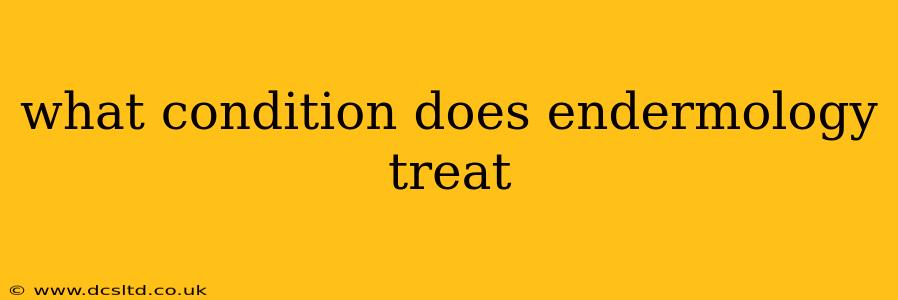Endermology, a non-invasive body contouring treatment, is used to address various aesthetic concerns. While not a cure-all, it's a popular choice for improving skin texture, reducing cellulite, and enhancing body shape. This article will delve into the specific conditions Endermology targets and explore how it works to achieve these results.
What is Endermology?
Endermology, also known as LPG Endermologie, utilizes a patented motorized roller system coupled with suction. This unique combination of mechanical stimulation and negative pressure is applied to the skin, creating a kneading effect. This process aims to:
- Stimulate blood circulation: Improving oxygen and nutrient delivery to tissues.
- Break down fat cells: Helping to reduce localized fat deposits.
- Reduce cellulite: Targeting the dimpled appearance often associated with cellulite.
- Improve lymphatic drainage: Helping to eliminate toxins and excess fluid.
- Boost collagen production: Leading to firmer, smoother skin.
What Specific Conditions Does Endermology Treat?
Endermology is primarily used to treat conditions related to skin texture, cellulite, and localized fat deposits. Let's explore these in more detail:
Cellulite:
This is arguably the most common condition treated by Endermology. The treatment works by breaking down the fibrous bands that contribute to the dimpled appearance of cellulite, improving skin smoothness and reducing the appearance of "orange peel" skin.
Localized Fat Deposits:
Endermology can help target stubborn areas of fat that are resistant to diet and exercise. While it isn't a weight-loss solution, it can help contour the body by reducing fat in specific areas.
Skin Texture:
The mechanical stimulation of Endermology can improve skin texture, leading to smoother, firmer skin. It can also help to improve skin elasticity and reduce the appearance of stretch marks.
Lymphedema (Sometimes):
While not its primary use, in some cases Endermology may be used to assist with lymphatic drainage in individuals with mild lymphedema. However, it is crucial to consult with a doctor or lymphedema therapist before using Endermology for lymphedema, as it is not a replacement for standard medical treatment.
What are the Contraindications of Endermology?
While generally safe, Endermology is not suitable for everyone. Contraindications include:
- Phlebitis or Thrombosis: Any condition affecting blood clots.
- Uncontrolled Hypertension: High blood pressure.
- Pregnancy:
- Certain Skin Conditions: Such as open wounds, infections, or severe eczema.
- Cancer: Individuals undergoing cancer treatment should consult their oncologist.
Does Endermology Treat Other Conditions?
It is important to manage expectations. Endermology is not a treatment for medical conditions like obesity or severe lymphedema. It is a cosmetic procedure focused on improving skin appearance and body contouring.
How Many Endermology Sessions Are Needed?
The number of sessions required varies depending on individual needs and the condition being treated. A typical treatment plan might involve several sessions spaced over a few weeks or months. Maintenance sessions may be recommended to maintain results.
Is Endermology Painful?
Most people describe the sensation as a deep tissue massage, feeling a bit of pressure and kneading. Discomfort is generally minimal, but everyone's experience is unique.
By understanding the conditions Endermology addresses and its limitations, you can make an informed decision about whether it's the right treatment option for you. Always consult a qualified medical professional for personalized advice and to rule out any contraindications.
